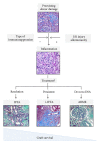The Interplay between inflammation and fibrosis in kidney transplantation
- PMID: 24991565
- PMCID: PMC4065724
- DOI: 10.1155/2014/750602
The Interplay between inflammation and fibrosis in kidney transplantation
Abstract
Serial surveillance renal allograft biopsies have shown that early subclinical inflammation constitutes a risk factor for the development of interstitial fibrosis. More recently, it has been observed that persistent inflammation is also associated with fibrosis progression and chronic humoral rejection, two histological conditions associated with poor allograft survival. Treatment of subclinical inflammation with steroid boluses prevents progression of fibrosis and preserves renal function in patients treated with a cyclosporine-based regimen. Subclinical inflammation has been reduced after the introduction of tacrolimus based regimens, and it has been shown that immunosuppressive schedules that are effective in preventing acute rejection and subclinical inflammation may prevent the progression of fibrosis and chronic humoral rejection. On the other hand, minimization protocols are associated with progression of fibrosis, and noncompliance with the immunosuppressive regime constitutes a major risk factor for chronic humoral rejection. Thus, adequate immunosuppressive treatment, avoiding minimization strategies and reinforcing educational actions to prevent noncompliance, is at present an effective approach to combat the progression of fibrosis.
Figures


Similar articles
-
No difference in degree of interstitial Sirius red-stained area in serial biopsies from area under concentration-over-time curves-guided cyclosporine versus tacrolimus-treated renal transplant recipients at one year.J Am Soc Nephrol. 2006 Jan;17(1):305-12. doi: 10.1681/ASN.2005030249. Epub 2005 Nov 23. J Am Soc Nephrol. 2006. PMID: 16306168 Clinical Trial.
-
High Intrapatient Variability of Tacrolimus Concentrations Predicts Accelerated Progression of Chronic Histologic Lesions in Renal Recipients.Am J Transplant. 2016 Oct;16(10):2954-2963. doi: 10.1111/ajt.13803. Epub 2016 Apr 21. Am J Transplant. 2016. PMID: 27013142 Clinical Trial.
-
New strategies using 'low-dose' mycophenolate mofetil to reduce acute rejection in patients following kidney transplantation.J Transpl Coord. 1999 Jun;9(2):114-8. doi: 10.7182/prtr.1.9.2.t4l566l63m0g1126. J Transpl Coord. 1999. PMID: 10703393 Clinical Trial.
-
Immunosuppressive treatment and progression of histologic lesions in kidney allografts.Kidney Int Suppl. 2005 Dec;(99):S124-30. doi: 10.1111/j.1523-1755.2005.09923.x. Kidney Int Suppl. 2005. PMID: 16336565 Review.
-
Is acute rejection the key predictor for long-term outcomes after renal transplantation when comparing calcineurin inhibitors?Transplant Rev (Orlando). 2009 Jan;23(1):47-52. doi: 10.1016/j.trre.2008.08.005. Transplant Rev (Orlando). 2009. PMID: 19027616 Review.
Cited by
-
The TGF-β1 Signaling Pathway as an Attractive Target in the Fibrosis Pathogenesis of Sjögren's Syndrome.Mediators Inflamm. 2018 Nov 26;2018:1965935. doi: 10.1155/2018/1965935. eCollection 2018. Mediators Inflamm. 2018. PMID: 30598637 Free PMC article.
-
Cinnabar induces renal inflammation and fibrogenesis in rats.Biomed Res Int. 2015;2015:280958. doi: 10.1155/2015/280958. Epub 2015 Feb 5. Biomed Res Int. 2015. PMID: 25734058 Free PMC article.
-
Renal transplant patients with preformed anti-HLA antibodies: early biopsy findings and clinical outcomes.J Bras Nefrol. 2019 Sep 12;42(2):201-210. doi: 10.1590/2175-8239-JBN-2018-0244. J Bras Nefrol. 2019. PMID: 31528982 Free PMC article.
-
Kidney allograft fibrosis: what we learned from latest translational research studies.J Nephrol. 2020 Dec;33(6):1201-1211. doi: 10.1007/s40620-020-00726-z. Epub 2020 Mar 19. J Nephrol. 2020. PMID: 32193834 Review.
-
Purinergic signaling in scarring.FASEB J. 2016 Jan;30(1):3-12. doi: 10.1096/fj.15-274563. Epub 2015 Sep 2. FASEB J. 2016. PMID: 26333425 Free PMC article. Review.
References
-
- Liu Y. Renal fibrosis: new insights into the pathogenesis and therapeutics. Kidney International. 2006;69(2):213–217. - PubMed
-
- Eddy AA. Molecular basis of renal fibrosis. Pediatric Nephrology. 2000;15(3-4):290–301. - PubMed
-
- Kisseleva T, Brenner DA. Mechanisms of fibrogenesis. Experimental Biology and Medicine. 2008;233(2):109–122. - PubMed
-
- Blank U, Essig M, Scandiuzzi L, Benhamou M, Kanamaru Y. Mast cells and inflammatory kidney disease. Immunological Reviews. 2007;217(1):79–95. - PubMed
Publication types
MeSH terms
Substances
LinkOut - more resources
Full Text Sources
Other Literature Sources
Medical

